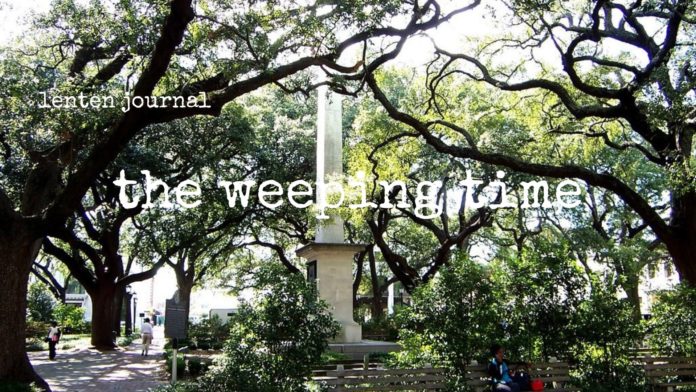We could not have asked for a more beautiful day in Savannah. The high temperature was in the upper seventies, there was a consistent breeze, and very little humidity. We walked from our hotel down to Bay Street, one block up and parallel to River Street, to find a place to eat lunch and then to traverse the Historic District to get our bearings as we prepare for the rest of the group to arrive in a few days.
The downtown area of Savannah is built around twenty-two squares, which are beautiful block-sized parks with giant oak trees whose branches are hung with Spanish moss the way my mom used to hang icicles on our Christmas tree. We probably saw seven or eight of them, each with at least one historical marker. In between we passed other buildings that had significance in Savannah’s story, and we began to recognize names: Oglethorpe, Greene, Wesley, to name a few.
We ate lunch at Treylor Park–because of the name, mostly–and had good food. Then we followed the cobblestones down to River Street, passing all kinds of tourist shops, and found the Waving Girl statue built to commemorate Florence Martus who greeted the ships entering the harbor by waving a cloth from the lighthouse on Cockspur Island in search of her lost lover–and she did it from 1887 to 1931, so I don’t think she was a girl.
Another marker in front of Independent Presbyterian Church honored Lowell Mason, a sacred music composer from New England who lived in Savannah for a time. He wrote, among other things, the hymn “My Faith Looks Up to Thee,” which we sang in church last Sunday.
We walked and read and walked and read and found nothing that spoke about the city’s history with slavery, or its history with civil rights. I learned tonight that there is an African American monument that was erected in 2002 (2002!) down by River Street, but we didn’t see it or any signs pointing to it.
We walked up Bull Street and came to Johnson Square, which holds a giant granite obelisk commemorating Nathaniel Greene along with eight markers that tell about Washington’s Southern tour, Christ Episcopal Church, John Oglethorpe, John Hearndon Mercer, the city plan of Savannah, and the Historic District itself.
But here’s the thing: Johnson Square was the site of the largest sale of human beings in the history of our country that took place in March of 1857. Over four hundred enslaved people were sold for a cumulative cost of $303,850, which would be about $10 million today. They called it “The Weeping Time.”
A hundred and sixty-six years later, we stood in the place where it happened–in a city built by enslaved people–and found no mention of it.
One of the enduring stories for me in the Hebrew Bible is that of Joshua telling the people to build an altar after God had delivered them. “Stack up the stones,” he said, “so that when the children ask why they are there you can tell them the story.”
Savannah is full of monuments and markers, stones stacked up to tell the stories of white people who founded the colony, who fought in wars, who built churches, and pretty much all of them owned slaves, though that part of the story is not repeated. None of the stones we saw were stacked up so the stories of enslaved people would be remembered, even though the city–hell, our country–would not exist without them. Instead, people walked through a beautiful park on their way home from work or to do something fun, because this is a fun town. They hid the story so well they have almost forgotten it.
A big part of there reason Ginger leads these trips is to remind us that the stories we learn as we travel are much like some of the stories that are closer to home that we have not told well. Connecticut was essential to the success of the slave trade, and a number of people were enslaved in the state. Eighty were enslaved in Guilford, one of them owned by a Congregational minister.
It’s hard to write about this without sounding sanctimonious. I know I am not saying anything new, or even saying it better than it has already been said. But walking across land that holds such a heinous and invisible history I saw that whether we tell the stories or not, we live with the consequences. Then again, if we don’t tell the stories, we will continue to magnify the consequences because we aren’t telling the truth. Until we do, we will live in the weeping time.
Peace,
Milton

Thank you for sharing this and thanks to Ginger for her insight and work as well.
Alas. Yes, the weeping time. (and how easily I type that this morning, though my heart is heavy as I type it…how easily I type it.)
Thank you for pausing to reflect on our country’s past. So sad that we cannot tell the true story of the dissension that fractured our country.
Thank you for shining a light on yet again another omission of our history. I’m halfway through reading “The OTHER Salvery, the Uncovered Story of Indian Enslavement in America” by Andres Resendez, of which little is written or taught.